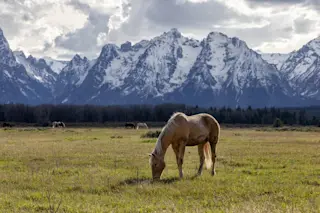“History is a bath of blood,” wrote William James, whose 1906 antiwar essay is arguably the best ever written on the subject. “Modern man inherits all the innate pugnacity and all the love of glory of his ancestors. Showing war’s irrationality and horror is of no effect on him. The horrors make the fascination. War is the strong life; it is life in extremis; war taxes are the only ones men never hesitate to pay, as the budgets of all nations show us.”
Our bloody nature, it can now be argued in the context of modern biology, is ingrained because group-versus-group competition was a principal driving force that made us what we are. In prehistory, group selection (that is, the competition between tribes instead of between individuals) lifted the hominids that became territorial carnivores to heights of solidarity, to genius, to enterprise—and to fear. Each tribe knew with justification that if it was not armed and ready, its very existence was imperiled. Throughout history, the escalation of a large part of technology has had combat as its central purpose. Today the calendars of nations are punctuated by holidays to celebrate wars won and to perform memorial services for those who died waging them. Public support is best fired up by appeal to the emotions of deadly combat, over which the amygdala—a center for primary emotion in the brain—is grandmaster. We find ourselves in the “battle” to stem an oil spill, the “fight” to tame inflation, the “war” against cancer. Wherever there is an enemy, animate or inanimate, there must be a victory. You must prevail at the front, no matter how high the cost at home.
Any excuse for a real war will do, so long as it is seen as necessary to protect the tribe. The remembrance of past horrors has no effect. From April to June in 1994, killers from the Hutu majority in Rwanda set out to exterminate the Tutsi minority, which at that time ruled the country. In a hundred days of unrestrained slaughter by knife and gun, 800,000 people died, mostly Tutsi. The total Rwandan population was reduced by 10 percent. When a halt was finally called, 2 million Hutu fled the country, fearing retribution. The immediate causes for the bloodbath were political and social grievances, but they all stemmed from one root cause: Rwanda was the most overcrowded country in Africa. For a relentlessly growing population, the per capita arable land was shrinking toward its limit. The deadly argument was over which tribe would own and control the whole of it.
Universal conflict
Once a group has been split off from other groups and sufficiently dehumanized, any brutality can be justified, at any level, and at any size of the victimized group up to and including race and nation. And so it has ever been. A familiar fable is told to symbolize this pitiless dark angel of human nature. A scorpion asks a frog to ferry it across a stream. The frog at first refuses, saying that it fears the scorpion will sting it. The scorpion assures the frog it will do no such thing. After all, it says, we will both perish if I sting you. The frog consents, and halfway across the stream the scorpion stings it. Why did you do that, the frog asks as they both sink beneath the surface. It is my nature, the scorpion explains.
War, often accompanied by genocide, is not a cultural artifact of just a few societies. Nor has it been an aberration of history, a result of the growing pains of our species’ maturation. Wars and genocide have been universal and eternal, respecting no particular time or culture. Archaeological sites are strewn with the evidence of mass conflicts and burials of massacred people. Tools from the earliest Neolithic period, about 10,000 years ago, include instruments clearly designed for fighting. One might think that the influence of pacific Eastern religions, especially Buddhism, has been consistent in opposing violence. Such is not the case. Whenever Buddhism dominated and became the official ideology, war was tolerated and even pressed as part of faith-based state policy. The rationale is simple, and has its mirror image in Christianity: Peace, nonviolence, and brotherly love are core values, but a threat to Buddhist law and civilization is an evil that must be defeated.
Since the end of World War II, violent conflict between states has declined drastically, owing in part to the nuclear standoff of the major powers (two scorpions in a bottle writ large). But civil wars, insurgencies, and state-sponsored terrorism continue unabated. Overall, big wars have been replaced around the world by small wars of the kind and magnitude more typical of hunter-gatherer and primitively agricultural societies. Civilized societies have tried to eliminate torture, execution, and the murder of civilians, but those fighting little wars do not comply.
Archaeologists have determined that after populations of Homo sapiens began to spread out of Africa approximately 60,000 years ago, the first wave reached as far as New Guinea and Australia. The descendants of the pioneers remained as hunter-gatherers or at most primitive agriculturalists, until reached by Europeans. Living populations of similar early provenance and archaic cultures are the aboriginals of Little Andaman Island off the east coast of India, the Mbuti Pygmies of Central Africa, and the !Kung Bushmen of southern Africa. All today, or at least within historical memory, have exhibited aggressive territorial behavior.
Next page: lethal legacy
Lethal legacy
Tribal aggressiveness goes back well beyond Neolithic times, but no one as yet can say exactly how far. It could have begun at the time of Homo habilis, the earliest known species of the genus Homo, which arose between 3 million and 2 million years ago in Africa. Along with a larger brain, those first members of our genus developed a heavy dependence on scavenging or hunting for meat. And there is a good chance that it could be a much older heritage, dating beyond the split 6 million years ago between the lines leading to modern chimpanzees and to humans.
A series of researchers, starting with Jane Goodall, have documented the murders within chimpanzee groups and lethal raids conducted between groups. It turns out that chimpanzees and human hunter-gatherers and primitive farmers have about the same rates of death due to violent attacks within and between groups. But nonlethal violence is far higher in the chimps, occurring between a hundred and possibly a thousand times more often than in humans.
The patterns of collective violence in which young chimp males engage are remarkably similar to those of young human males. Aside from constantly vying for status, both for themselves and for their gangs, they tend to avoid open mass confrontations with rival troops, instead relying on surprise attacks. The purpose of raids made by the male gangs on neighboring communities is evidently to kill or drive out their members and acquire new territory. There is no certain way to decide on the basis of existing knowledge whether chimpanzees and humans inherited their pattern of territorial aggression from a common ancestor or whether they evolved it independently in response to parallel pressures of natural selection and opportunities encountered in the African homeland. From the remarkable similarity in behavioral detail between the two species, however, and if we use the fewest assumptions required to explain it, a common ancestry seems the more likely choice.
The principles of population ecology allow us to explore more deeply the roots of mankind’s tribal instinct. Population growth is exponential. When each individual in a population is replaced in every succeeding generation by more than one—even by a very slight fraction more, say 1.01—the population grows faster and faster, in the manner of a savings account or debt. A population of chimpanzees or humans is always prone to grow exponentially when resources are abundant, but after a few generations even in the best of times it is forced to slow down. Something begins to intervene, and in time the population reaches its peak, then remains steady, or else oscillates up and down. Occasionally it crashes, and the species becomes locally extinct.
What is the “something”? It can be anything in nature that moves up or down in effectiveness with the size of the population. Wolves, for example, are the limiting factor for the population of elk and moose they kill and eat. As the wolves multiply, the populations of elk and moose stop growing or decline. In parallel manner, the quantity of elk and moose are the limiting factor for the wolves: When the predator population runs low on food, in this case elk and moose, its population falls. In other instances, the same relation holds for disease organisms and the hosts they infect. As the host population increases, and the populations grow larger and denser, the parasite population increases with it. In history diseases have often swept through the land until the host populations decline enough or a sufficient percentage of its members acquire immunity.
There is another principle at work: Limiting factors work in hierarchies. Suppose that the primary limiting factor is removed for elk by humans’ killing the wolves. As a result the elk and moose grow more numerous, until the next factor kicks in. The factor may be that herbivores overgraze their range and run short of food. Another limiting factor is emigration, where individuals have a better chance to survive if they leave and go someplace else. Emigration due to population pressure is a highly developed instinct in lemmings, plague locusts, monarch butterflies, and wolves. If such populations are prevented from emigrating, the populations might again increase in size, but then some other limiting factor manifests itself. For many kinds of animals, the factor is the defense of territory, which protects the food supply for the territory owner. Lions roar, wolves howl, and birds sing in order to announce that they are in their territories and desire competing members of the same species to stay away.
Next page: wars past, present, future
Wars past, present, future
Humans and chimpanzees are intensely territorial. That is the apparent population control hardwired into their social systems. What the events were that occurred in the origin of the chimpanzee and human lines—before the chimpanzee-human split of 6 million years ago—can only be speculated. I believe that the evidence best fits the following sequence. The original limiting factor, which intensified with the introduction of group hunting for animal protein, was food. Territorial behavior evolved as a device to sequester the food supply. Expansive wars and annexation resulted in enlarged territories and favored genes that prescribe group cohesion, networking, and the formation of alliances.
For hundreds of millennia, the territorial imperative gave stability to the small, scattered communities of Homo sapiens, just as they do today in the small, scattered populations of surviving hunter-gatherers. During this long period, randomly spaced extremes in the environment alternately increased and decreased the population size so that it could be contained within territories. These demographic shocks led to forced emigration or aggressive expansion of territory size by conquest, or both together. They also raised the value of forming alliances outside of kin-based networks in order to subdue other neighboring groups.
Ten thousand years ago, at the dawn of the Neolithic era, the agricultural revolution began to yield vastly larger amounts of food from cultivated crops and livestock, allowing rapid growth in human populations. But that advance did not change human nature. People simply increased their numbers as fast as the rich new resources allowed. As food again inevitably became the limiting factor, they obeyed the territorial imperative. Their descendants have never changed. At the present time, we are still fundamentally the same as our hunter-gatherer ancestors, but with more food and larger territories. Region by region, recent studies show, the populations have approached a limit set by the supply of food and water. And so it has always been for every tribe, except for the brief periods after new lands were discovered and their indigenous inhabitants displaced or killed.
The struggle to control vital resources continues globally, and it is growing worse. The problem arose because humanity failed to seize the great opportunity given it at the dawn of the Neolithic era. It might then have halted population growth below the constraining minimum limit. As a species we did the opposite, however. There was no way for us to foresee the consequences of our initial success. We simply took what was given us and continued to multiply and consume in blind obedience to instincts inherited from our humbler, more brutally constrained Paleolithic ancestors.
Also see John Horgan's response to this piece, “No, War Is Not Inevitable.”
Excerpted from The Social Conquest of Earth by Edward O. Wilson, published in April by Liveright Publishing Corporation, a division of W. W. Norton & Company, Inc. Copyright © 2012.
Fatality rate due to conflict
The last century has been called the Century of Total War: World Wars I and II, the Korean War, the Vietnam War, and other conflicts took an estimated 187 million human lives. But after analyzing archaeological and ethnographic data, social scientist Samuel Bowles of the Santa Fe Institute in New Mexico has reported even worse fatalities in hunter-gatherer societies stretching back at least 10,000 years and continuing to the present. War appeared to serve a purpose, culling population whenever numbers rose too high. Counterintuitively, war might have also fostered altruism: Since winning battles required cooperation, wartime mortality might have aided the evolution of an altruistic human nature through the process of natural selection.
7% Southern Sweden
Remains by an ancient lagoon called Skateholm indicate a 7% adult mortality rate due to warfare 6,100 years ago.
21% Southern Ukraine
Analysis of Vasiliv’ka III, an 11,000-year-old burial site, shows that 21% of adults died as a result of warfare. Another site, Volos’ke, shows evidence of a 22% adult mortality rate due to warfare.
30% Northern India
At Sarai Nahar Rai, a site inhabited by hunter-gatherers between 3,140 and 2,860 years ago, war caused 30% of adult deaths.
46% Northern Sudan
14,000 to 12,000 years ago, 46% of Nubian adults died in war.
21% Northeastern Australia
Among the Murngin, a group of maritime foragers, war accounted for about 21% of adult deaths between 1910 and 1930.
23% British Columbia
Across 30 sites dating to between 5,500 and 340 years ago, 23% of all adults died in war.
6% Southern California
Across 28 hunter-gatherer sites, warfare led to 6% of adult deaths between 5,500 and 630 years ago.
17% Venezuela-Colombia border
Before first contact in 1960, warfare caused 17% of adult deaths among the Hiwi, who were foragers.
30% Eastern Paraguay
Ethnographic evidence implies that war caused 30% of the deaths among hunter-gatherers here prior to Western contact in 1970.















